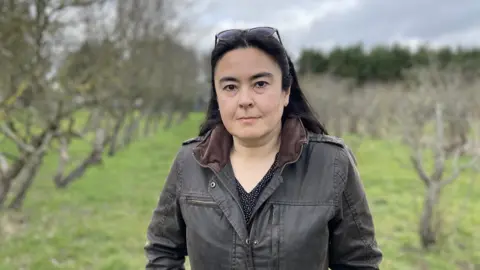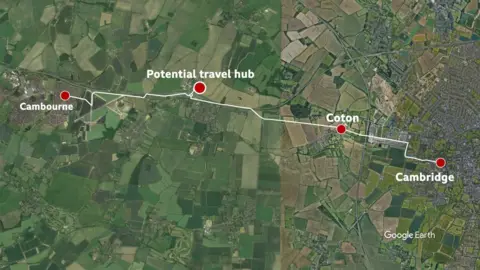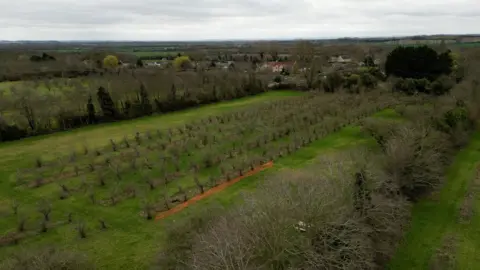Cambourne to Cambridge busway threat to hundreds of orchard trees
 BBC
BBCA new £160m busway in Cambridgeshire promises to relieve congestion and improve public transport, but its proposed route cuts through an orchard dating back to 1922 as well as greenbelt land. But what is the plan and what do those affected think?
"These trees survived World War Two, they fed the people of Cambridgeshire, but they won't survive Cambridgeshire County Council if they vote 'yes'," says Anna Gazeley.
She is walking among the fruit trees at Coton Orchard, a century-old 60-acre site owned by her family.
It is a Habitat of Principal Importance, likely home to several protected species and in the path of a proposed new busway.
The transport link promises to take cars off the road, make buses more reliable and cut journey times between Cambridge and Cambourne - a growing new town eight miles (13km) to the west of the city.
Those behind it say it is needed to serve the existing population, as well as thousands of new homes planned along the route.
County councillors are due to vote on the £160m plans on Tuesday.
What are the plans?
- Known as C2C, the 8.6 mile (14km) busway would link Cambridge and Cambourne, via Hardwick, Coton and Bourn airfield
- It would include optically-guided electric or hybrid buses on the route
- Bus journeys would be 19 minutes faster between Cambridge and Cambourne
- A new 30-acre (12 hectare) park and ride north of Hardwick would be created
- About 500 trees would be removed from Coton Orchard
- There is a commitment to a minimum 10% net biodiversity gain, including 1,500 new trees

Ms Gazeley, 52, fears that if the plans are approved, hundreds of the fruit trees - as well as many others - could be lost.
"I can't overstate the ecological damage that will be done to the whole site, not just the site of the eventual C2C busway," she says.
The Greater Cambridge Partnership - a body that includes three councils, businesses and Cambridge University - has developed the plans.
It says 500 trees at the orchard need to be removed, but believes the environmental impact would be "lessened to non-significant" within 15 to 30 years by planting new habitats elsewhere.
Coton Orchard contains about 1,000 trees. It grows 26 varieties of apples, as well as pears and plums.
Ms Gazeley says the site is home to "woodcocks, three sorts of woodpeckers, badgers and foxes", among others, including bats.
"These birds aren't going to hang around. They will fly off somewhere, not find food and die," she says.
"[The busway] would fragment it to the point that actually the whole site will be lost in terms of ecological value.
"They will plough through with bulldozers, dump-trucks and churn up everything."
'I'd be shattered'
Ms Gazeley's father Albert bought the orchard in 1996 after returning to Cambridgeshire from Hong Kong.
What would a 'yes' vote mean to her?
"I'd be shattered, to be honest. It's been seven years, which has been absolutely exhausting.
"My father bought this nearly 30 years ago as a way to stop development, to preserve the fruit-growing heritage of Cambridgeshire and to preserve his own memories of growing up here in Cambridge."

She and other campaigners believe a new bus lane should be created on the existing roads rather than building the busway, which would also pass through farmland currently designated as greenbelt.
But Stephen Drew, a Liberal Democrat councillor representing Cambourne on South Cambridgeshire District Council, supports the plans.
"Cambourne residents have been waiting a long time for this," he says. "At the moment transport links to Cambridge remain really poor."
He adds his constituents have recently seen cuts to bus services and do not have any direct safe cycle routes into Cambridge.
About 2,350 new homes are planned for a development at Cambourne West and another 3,500 at Bourn airfield.
He adds: "It is essential that the transport links in the area reflect the reality of the population. Lots of young people in Cambourne will come into Cambridge to go to college - at the moment transport is extremely difficult."
 Stephen Drew
Stephen DrewAsked about the ecological impact of the plans, he says people in Cambourne "completely understand" the concerns.
"It's entirely possible to do these things and then put in mitigation measures that increase the biodiversity that's there," he continues.
Councillors are being asked to approve the county council making an application to the Secretary of State for Transport for permission to go-ahead with the scheme, which is a "priority project" for the Greater Cambridge Partnership (GCP).
It is one of four "travel corridors" being developed by the GCP and aims to "see a step change in transport infrastructure, create jobs and boost the local economy".
The GCP says: "The project will provide better public transport services and active travel opportunities for thousands of people in growing communities to the west of the city, helping to cut congestion on the roads, reduce carbon emissions and improve air quality for everyone.
"To build infrastructure of this scale, we need to submit an application to government via the Highways Authority. If it agrees with the proposals, Cambridgeshire County Council will submit a Transport and Works Act Order (TWAO) to the government on the GCP's behalf in the summer for approval."
